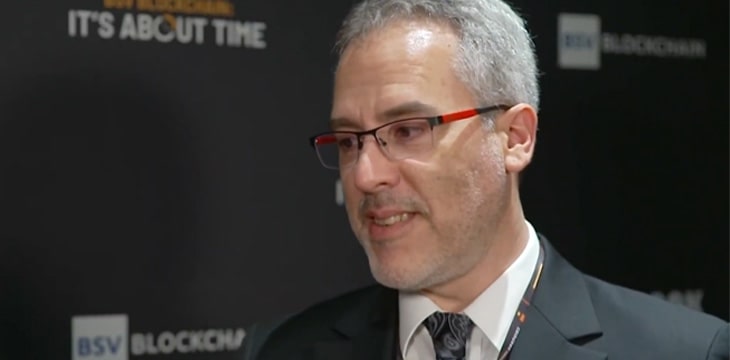|
Getting your Trinity Audio player ready...
|
Bitcoin’s favorite metaverse person, Transmira CEO and founder Robert Rice, kicked off the presentations at the recently held CoinGeek Conference New York, where he talked about virtual goods, meta pets, avatars, 3D scanners, and more.
On the sidelines of the event, Rice joined CoinGeek Backstage host Stephanie Tower to talk about Omniscape and Transmira’s latest developments towards creating an experiential reality (XR) world. Transmira, the developer behind the metaverse platform Omniscape, builds augmented reality (AR) for different brands, businesses, and content creators.
“We’re basically building Omniscape, which is a metaverse platform. We’re building it all on Bitcoin SV because it’s fast, scalable, and very inexpensive to do transactions. What makes this unique is we’re blending both augmented reality and virtual reality together and tying it to real-world locations,” Rice explained. “So it’s not a social VR game. It’s not an AR novelty thing. We’re literally building the foundations of what the metaverse is and what it’s going to be as it evolves and changes the world.”
At the moment, Omniscape is busy rolling out the first bits of pieces on creating a city-scale digital twin platform, 3D pets, and 3D body scanners.
“We’ve got a whole cool virtual real estate sort of platform. We’re working on some other things that we’re calling meta pets. So you’ll have little 3D pets and animals follow you around, you can train and do stuff with, which I’m sure kids will love. And those we’re ultimately involved in is what we call artificial life intelligent agents. So instead of a pet, you’ll have another 3D person or avatar that you can say, ‘Hey, book me some tickets on a plane.’ [It’s] kind of like Amazon Alexa but having an avatar or hologram you can talk to. Then, of course, we’re about to do some amazing city-scale digital twin stuff by the time CES rolls around in January,” Rice said.
At the conference, Transmira debuted its 3D body scanner, which uses several cameras and infrared scanners to develop a super high-resolution scan of a person.
According to Rice: “The idea basically started when people go into Fortnite or Second Life or a lot of these games you have an avatar that represents yourself. That’s going to be important and necessary for the metaverse. So, we thought, okay well, what can we do that’s cool here, but also your identity is really important. Being able to protect it, [your] privacy and have it follow you. So, we’re kind of combining identity on chain like as an NFT but also tied to your 3D representation of yourself. Kind of all-in-one.”
He added, “[It] makes a very lifelike avatar, but then we tokenize that, we link your identity to it. Then you’re going to be able to see yourself in augmented reality and do some fun things, but you’ll also be able to use that to navigate around some of the 3D worlds and stuff at the same time.”
Another cool feature of the 3D scanner is that the owners get to own the avatar 100%. “Not only do you have control over your appearance, your likeness, and your avatar, but we’re gonna make it easy for you to say: ‘Hey, I’m fine with other people using it.’ So if you’re a celebrity or a pro athlete, maybe you don’t mind somebody paying at buck 95 to have your hologram wish [fans] happy birthday,” Rice said.
The company has unofficially soft launched the metaverse products, although Rice said everything is still in late beta testing. “We’re going to be rolling stuff out every couple of months for now until the end of time. It’s an evolving process, but we’ve got a really cool detailed road map,” he said.
Rice wraps the interview by explaining how they are also working on linking virtual goods in exchange for real-world products.
“The virtual goods is a piece we haven’t mentioned. That’s kind of basically, instead of walking around looking for Pokemon, you’ll be able to walk around and find 3D-branded things in augmented reality. Like a 3D Starbucks coffee cup. You can pick it up, collect it, and then go to the store and exchange it for a real coffee. Being able to link a 3D object to something [with] a real-world value that’s huge and amazing, and I think that’s the future of where the metaverse is going to go,” he concluded.
Watch: CoinGeek New York presentation, AR & VR & the Metaverse on Blockchain

 01-07-2026
01-07-2026 




